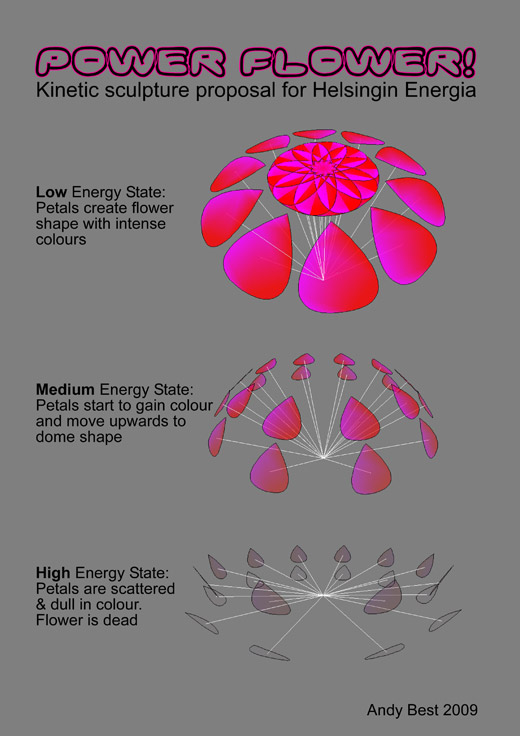ANDY BEST: KINETIC SCULPTURE TO SYMBOLISE ENERGY CONSUMPTION

The concept is to provide an instantly recognisable and understandable reading of the current energy consumption. It requires no knowledge or understanding of the energy data or any artistic appreciation. Every person, young or old, can look at the sculpture and immediately understand the message. The idea can be easily scaled to any location and available energy consumption data. For example the basic concept could be produced as table top objects for home or office, or a large public sculpture can be created that will symbolise energy consumption for a local area, city, country – or for that matter the whole world (if such data is obtainable!). A large sculpture could be made such that it can be toured around different areas for temporary installation, acting as a focal point for local energy awareness initiatives.
Technical Concept
The form of the sculpture is controlled by small electric stepper motors. The motors are positioned according to energy consumption data being fed to the sculpture. The sculpture is NOT continuously moving, rather it takes a position based on an average reading from the last n hours (the value n is set according to the location, available data, etc). If we take n to be 6 hours, then four times a day the sculpture will take up a new position – if, of course, the average reading has changed significantly.
The sculpture will have 3 positions corresponding to low, medium and high energy consumption. The visual representation will also correspond to the desired message: low energy consumption will have a positive representation, while high energy consumption will be symbolised by a negative representation (details below).
The sculptures can have colour control to indicate local heating energy consumption or ambient temperature. As lights only work well during hours of darkness (if outside) the main focus of the proposal is on the visual form, so that the sculpture functions 12 months a year and not just during winter.
The energy consumption of the sculpture itself is reduced as the motors only function four times a day. This is important as the work itself is meant to create awareness of energy usage. In the case of sculptures which have colour indication for temperature and heating, this is created with arrays of RGB leds which have very low energy consumption. Any colour can be created by controlling the current to the led.
The sculpture control system uses microcontrollers (Arduino, PIC, etc) for positioning the stepper motors and controlling the colour of the leds. Data is fed from the Internet (in the case of a public sculpture) or from a domestic energy data reader, into a control PC. The PC is connected to the microcontroller(s) inside the sculpture, which then set the positions of the motors at the appropriate time intervals.
Visual Concepts
I propose three different visual ideas. I don’t see these as exclusive, as the technical concept could be used with other forms and visual ideas.
1. Power Flower: A stylised flower is created by petal shaped forms on the end of long thin shafts. At the base centre point each shaft is controlled and positioned by a stepper motor. Each petal is created from an array of led lights. When power consumption is very high, the flower is dead – the petals are spread down on and near the ground, and their colour is dark. As energy consumption lowers, so the petals rise up and their colours become brighter. At the lowest energy consumption level a beautiful flower is created. The colour of the petals can be linked to the heating usage/ambient temperature, in which case the position of the petals indicates the energy consumption and colour indicates heating consumption. The sculpture can function as a large scale public work or as a table-top domestic or office ornament. It could also be designed to attach to a wall so it could be hung next to a clock, for example.
2. Kuusen voima: The spruce or Christmas tree symbolises not only the power of nature but also Finland and her values. I propose a spruce which bends due to the weight of energy consumption – the tree is straight and upright when there is low energy use, it is bent near to the ground at times of high energy consumption. The tree trunk is made up of a chain of metal tubing sections each containing a stepper motor. The motors control the amount of bend of the tree. The tree branches hang loose from the trunk, so that as the tree bends under the weight of energy consumption, so the branches hang down. The whole tree is constructed from shiny reflective metal (stainless steel, aluminium, chromed steel, etc). Conceptually the sculpture would function best as a large scale public sculpture in a city square, as a doppelganger for the traditional civic Christmas tree.
3. Gnome Alone: Just as the humble garden gnome has guarded many a suburban flower bed over the years, I propose a humorous, yet seriously intended guardian of domestic energy consumption, although he could also be placed as a life (human) sized public sculpture. The gnome has three positions:
a. Happy! Energy consumption is low. The gnome is standing up, hands in the air.
b. Grumpy! Medium consumption. The gnome squats, head down.
c. Dead! High energy consumption. The gnome lies dead on the ground.
The gnome is controlled by a series of stepper motors positioned at the joints in his body. His feet are attached securely to a base which contains the control mechanisms. The gnome’s body would be made from cast aluminium. He can be painted like a traditional gnome, patinated to appear like a bronze sculpture, or left in the natural state.